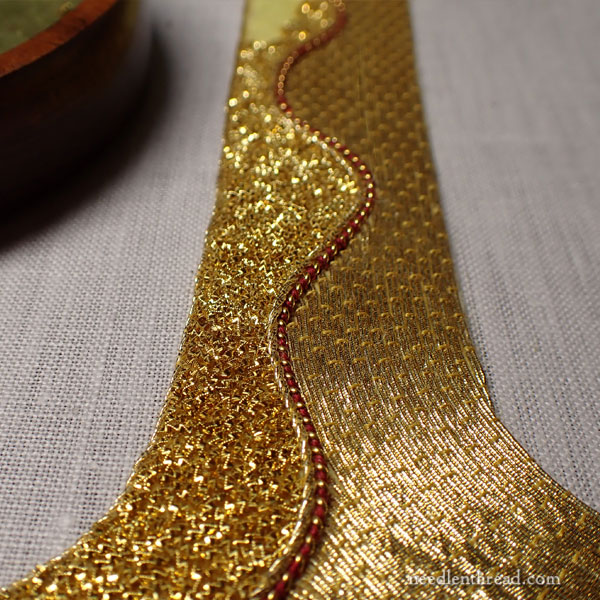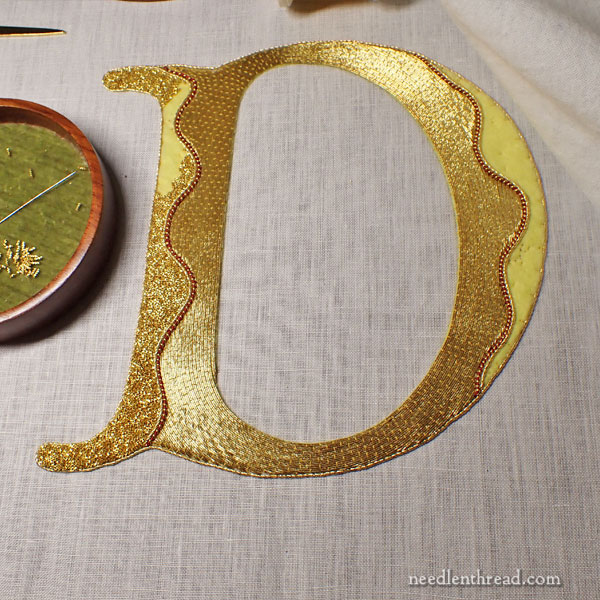Anna sits on her side of the frame.
I sit on my side of the frame.
We’re catty-corner to each other, each hugging the edge of the slate frame and trying to manipulate our arms around the trestles as we embroider letters situated near the edge of the ground fabric.
We work pretty much in silence, except for some soft background music.
And slowly and steadily, we make minute progress on the goldwork lettering that we’ve been working on since last spring.
It’s been a while since we’ve been able to sit and concentrate on embroidery, but at long last, we’re finally able to dedicate specific time to stitching.

With the new year underway and our new work space settled, we are able to divide the work week into various categories: production, manufacturing, and stitch time.
We break each time category down further, according to the tasks that we each undertake. My production time, for example, might be different from Anna’s. I might be writing during production time. She might be packaging or shipping.
If we’re manufacturing, we split up tasks. I might be labeling new twists of thread. She might be making the twists. She might be cutting fabric. I might be transferring designs. Or weighing beads. Or making up kits.
But during stitch time, guess what we’re both doing? You bet!
Our dedicated stitching time happens on two levels: the “extra” level (that’s the goldwork – it’s beyond our normal scope of our work) and the “ordinary” level (the projects directly related to Needle ‘n Thread).
The “extra” involves those projects that we agree to do, whether they are bespoke or voluntary, that we have an obligation to finish by a deadline. It is expedient (especially now, as the deadline on this goldwork nears) that we set aside specific work time during the week to make progress on these projects. We also work outside of work time on them – on the weekends, evenings – whenever either or both of us wants to or can.
The “ordinary” involves those projects that we develop from design to finish, photographing along the way, taking notes and writing instructions, so that we can eventually share them with you through Needle ‘n Thread. This includes the stitch-along projects that show up on the blog as well as specialty designs for kits. This year, we have a few specialty kits lined up to release, and we have a new series of Stitch Snippets for the blog.

On my side of the embroidery frame, I’m working on chip work. This involves cutting tiny pieces of #10 bright check purl – a very fine, spring-like, faceted wired thread – and sewing the little chips on like beads to fill open areas on the letters. You can read about chip work up close in this article from a previous goldwork project.
On her side of the frame, Anna is finishing up the couching work with passing thread, and she’s adding twist and pearl purl wrapped with read silk to the letters. You can read about stretching pearl purl here. It’s one of my favorite techniques!
Eventually, I’ll switch to her side of the frame and she’ll switch to mine, and we’ll go back and forth, dedicating our time to the aspects of goldwork that we each particularly like better or that we’re better at.
Right now, it’s all chip work for me, because Anna is not fond of chip work.
And it’s all plunging and couching and stretching and twisting for her, because… well, because Anna is not fond of chip work.

I like chip work. I like the effect, especially. But I like the randomness of it, too. Anna’s not too fond of Random.
However, I liked chip work Much Better when I had better vision. I find it considerably more difficult with the blind spot in my eye. It’s definitely slower, and I can’t manage it without a magnifier.
My Magnifier Idea
Incidentally, I wish someone would invent an “over the head” magnifier to mount above frames or above a table, so that the magnifier reaches down from above. Picture a bar fixed to two upright side legs. The legs fix to your frame or they stand on your table, and along the bar, you can slide the magnifier, or fix it at intervals, and pull it down from above. It would be much less awkward than a stand magnifier that you have to manipulate over the edge of your frame, and then somehow avoid elbowing every time you move.
Has anyone out there tried anything like that? I’d love to hear!
I wonder if I could rig something with a clamp-on magnifier…
Looking for More Information on this Project?
Well, my friends, we’re making progress on the goldwork! And that’s the whole point of today’s article. I just want you to see that we are actually embroidering in the studio again!
If you’d like to read about this project, you can find the back articles on it under the topic tag “Goldwork” for now. I’ll eventually be making an index for this project, so that you can easily find all the articles for it, arranged chronologically as the project develops. I keep indexes for most projects on Needle ‘n Thread right here, under Tips & Techniques, if you’re ever in the mood for browsing past projects!
Happy Monday!



